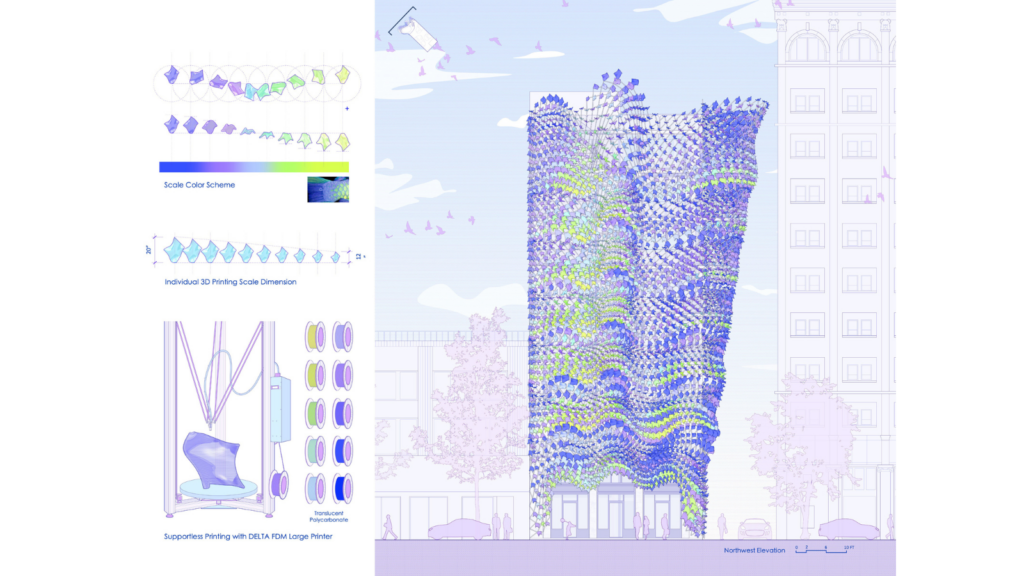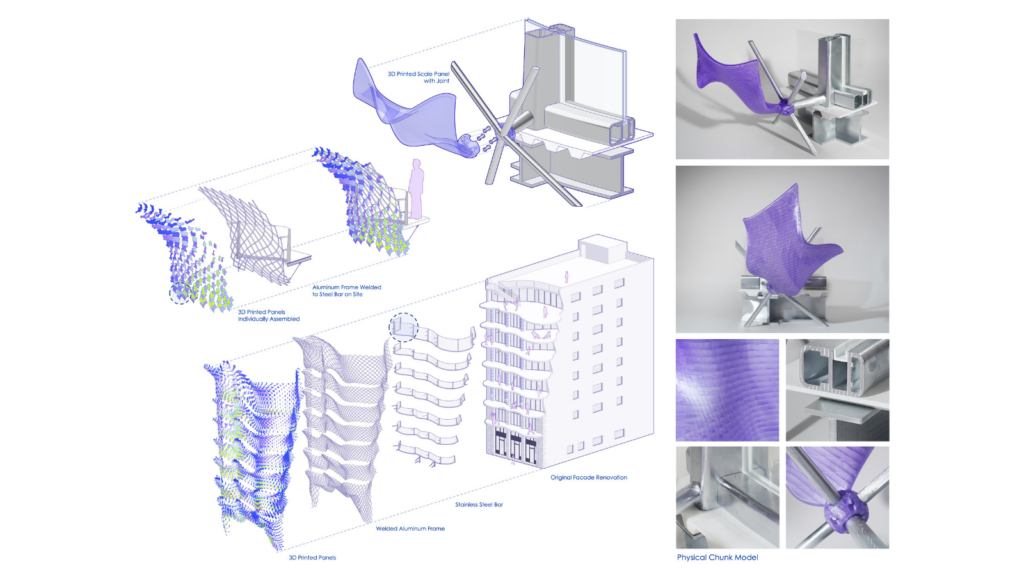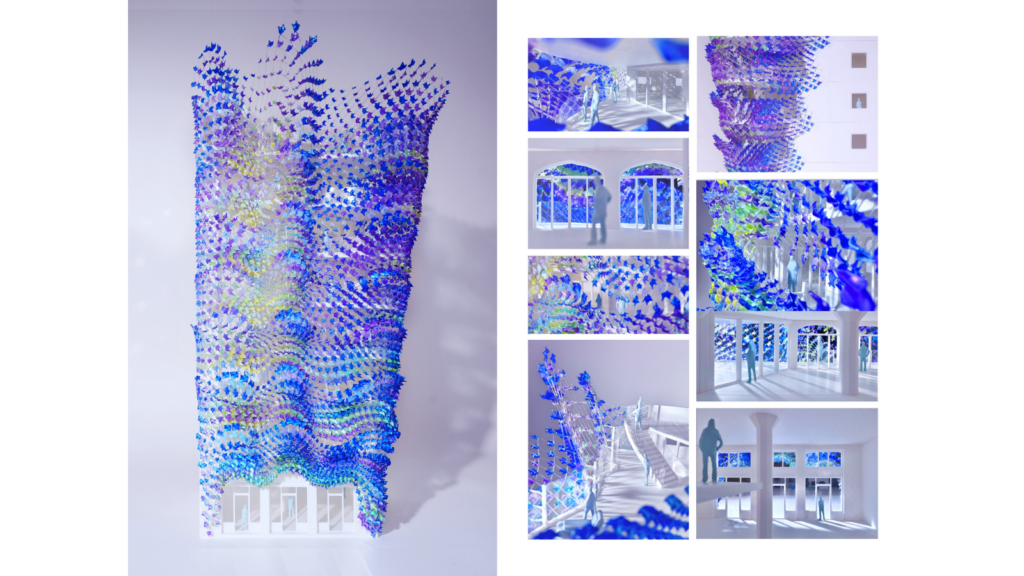
Chaoying Zhao
University of California, Los Angeles | Architecture & Urban Design
Professor: Julia Koerner
Fish scales are small, hard plates embedded in the skin of most jawed fishes. Serving as a protective armor, these scales enhance camouflage through reflective and color properties and may offer hydrodynamic benefits as well [1]. There are four main types of fish scales: cycloid, ctenoid, ganoid, and placoid, each possessing unique characteristics tailored to specific environments and life strategies.
This project focuses on studying different types of fish scales and their mechanism to adapt to the natural environment, so as to reflect in the facade renovation of the sparkle factory. The impact of scales’ shape, opening angle, size variety, density, and the curvature of its attached curved surface on its protective properties, so as to explore its role in wind capture and radiation protection as a building facade. At the same time, its aesthetically pleasing diagonal arrangement and rhythm created by repetition, and metallic and multi-color glazing also provide new vitality to old buildings.
[1] “Scale.” Etymonline. Retrieved 28 April 2019, from https://www.etymonline.com/search?q=scale
Scale Weave
The project reimagines conventional architecture by inverting the typical short-front, deep-facade building layout. Instead, we create public and semi-public communal spaces between each unit, encouraging interaction. This design forms long, slender bar-shaped buildings that eliminate the need for traditional corridors. The building cores not only serve as circulation points but also as social spaces where residents can gather and interact.
This concept draws from a very European approach to living, where communal areas are more than just functional spaces with generic furniture. We maximize the surface area surrounding the building cores, transforming them from underutilized service spaces into areas where neighbors can share a coffee or host weekend gatherings. By eliminating long, impersonal corridors, we foster greater sociability and interaction among residents. Additionally, the open-air cores provide natural ventilation, significantly reducing energy costs and taking full advantage of California’s exceptional climate. Having residents interact with the natural environment before entering their homes has been shown to improve overall comfort and well-being.
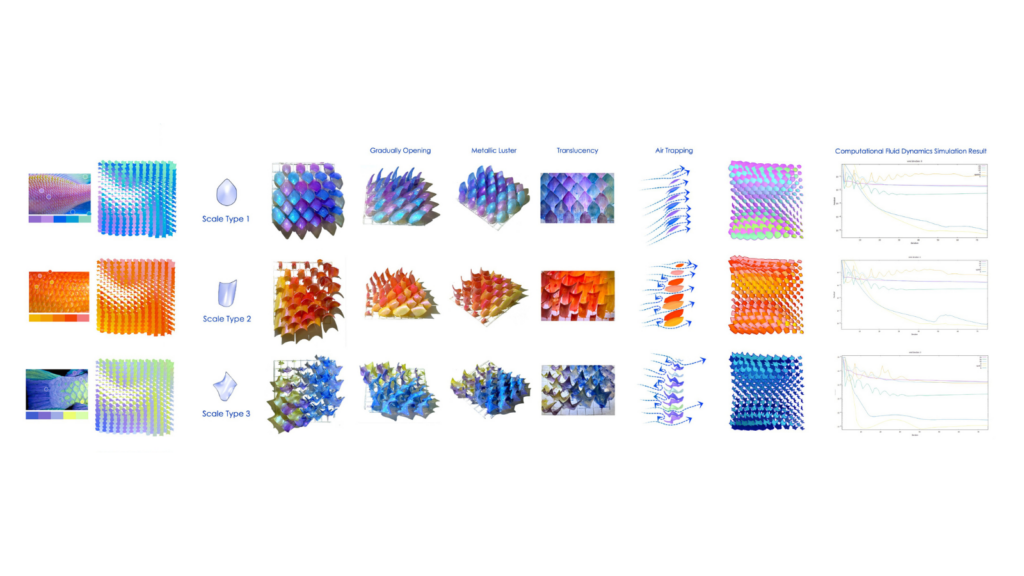
The concept behind the scale shield revolves around emulating the natural arrangement, organization, color, and material of fish scales. This innovative approach serves a dual purpose: it not only enhances the mask’s aesthetic appeal but also bolsters its functionality. By manipulating factors such as the open angle, curvature, and material composition of these scales, the mask is engineered to cater to a wide range of needs associated with facial protection.
One of the primary functions of the scale shield is sun protection. The arrangement and curvature of the scales can be adjusted to shield the wearer’s face from harmful UV rays effectively. Moreover, these scales can also facilitate ventilation, allowing for a continuous flow of fresh air while wearing the mask. This prevents discomfort and the accumulation of moisture, ensuring that the wearer remains cool and comfortable even in warm weather conditions.
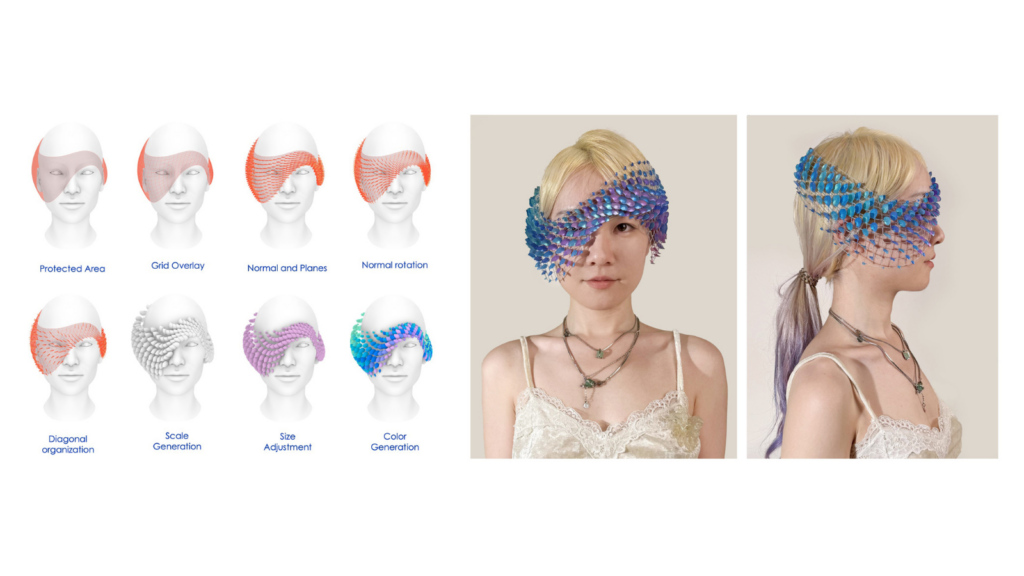
The building’s design promotes diversity by combining different unit types—studios, one-bedrooms, and two-bedrooms—within the same structure, encouraging interaction among various social groups and fostering a sense of community. Isolating residents of the same age group often fails to create a vibrant community, but this mix of living spaces helps residents of different ages and backgrounds to coexist and socialize.
Parking, a critical consideration in Los Angeles, is integrated seamlessly into the design. The modular units on the ground floor are strategically removed to allow for parking access from the primary vehicular corridors while maintaining a clean, uninterrupted facade on the courtyard side.
In conclusion, the scale shield represents a groundbreaking development in facial protection technology. By mimicking the intricate design of fish scales, it offers a unique blend of aesthetics and functionality. Through rigorous scientific research and CFD simulations, this innovative face mask is designed to provide superior sun protection, ventilation, thermal insulation, and overall protection for the wearer, all while ensuring maximum comfort and adaptability. The future of facial protection has arrived with the scale mask, promising enhanced safety and comfort in a variety of environmental conditions.
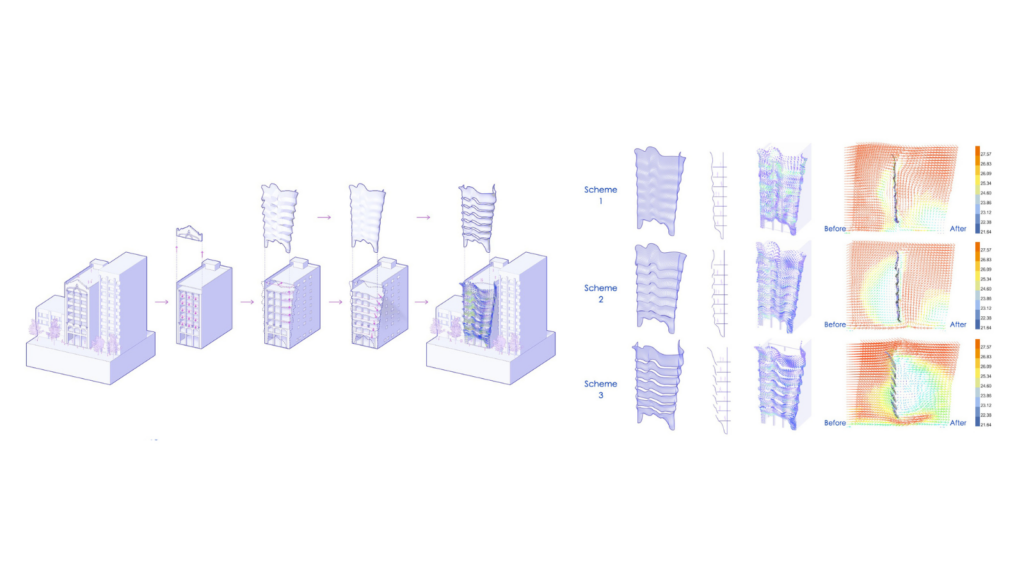
In the third phase of the research, the focus is on the development of a 3D printing system for scales, encompassing aspects such as color, material, texture, shape, printing technology, efficiency, performance, and sustainability.
To replicate the vibrant colors of the fish scale system, different methodologies are employed for the model and the actual application. For the model, light-curing resin 3D printing is chosen for its ability to meet the requirements for precision, fineness, thinness, and strength. Despite the integrated printing of scales and supporting frames necessitating some support structures, it is significantly less than in Fused Deposition Modeling (FDM) printing, and these supports are easily removable post-curing, which also enhances the strength. Each scale is meticulously hand-painted with UV pigment to achieve a unified appearance, characterized by metallic sheen, a broad color spectrum, and translucency.
For actual applications, performance enhancement dictates the scale system’s design, structure, and printing methodology. Computational Fluid Dynamics (CFD) simulations were conducted to assess the impact of variations in scale size, positioning, and angulation on system performance. The simulations, across three different sections, revealed a general trend of decreasing residuals for velocity and pressure, indicating a stable solution convergence. The fluctuating turbulence indicators, epsilon and k, suggest complex flow modeling, yet their general downward trend indicates effective heat and airflow management. Comparative analysis showed that less dense areas allowed more heat passage, whereas denser sections effectively blocked and redirected heat flow, establishing a direct correlation between scale system density and thermal performance.
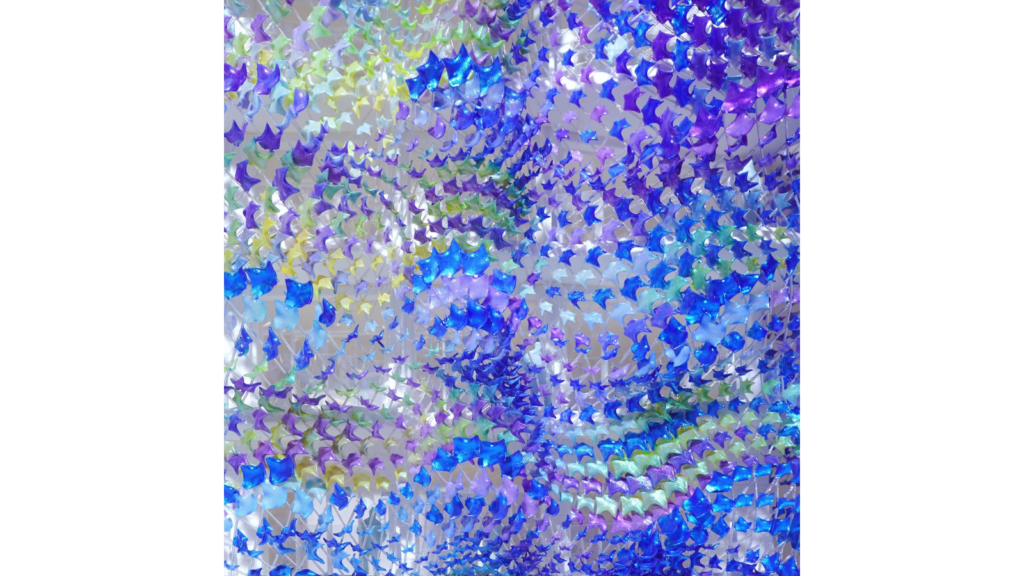
The structural frame of the façade system is designed to prevent deformation, incorporating metal supports distinct from the 3D-printed scales. Individual scale panels, crafted through 3D printing, are assembled on an aluminum wireframe, secured by an additional steel layer.
Cost and sustainability comparisons highlight polycarbonate’s advantages over mammoth resin, including lower cost, reduced machinery expenses, superior durability, impact resistance, lighter weight, broader color range, better UV protection, and lesser post-processing needs. Moreover, polycarbonate’s thermoplastic nature facilitates recycling, with a potential recyclability range of 70-90%, compared to the 10-50% for mammoth resin, which has limited recycling options and requires extensive post-processing.
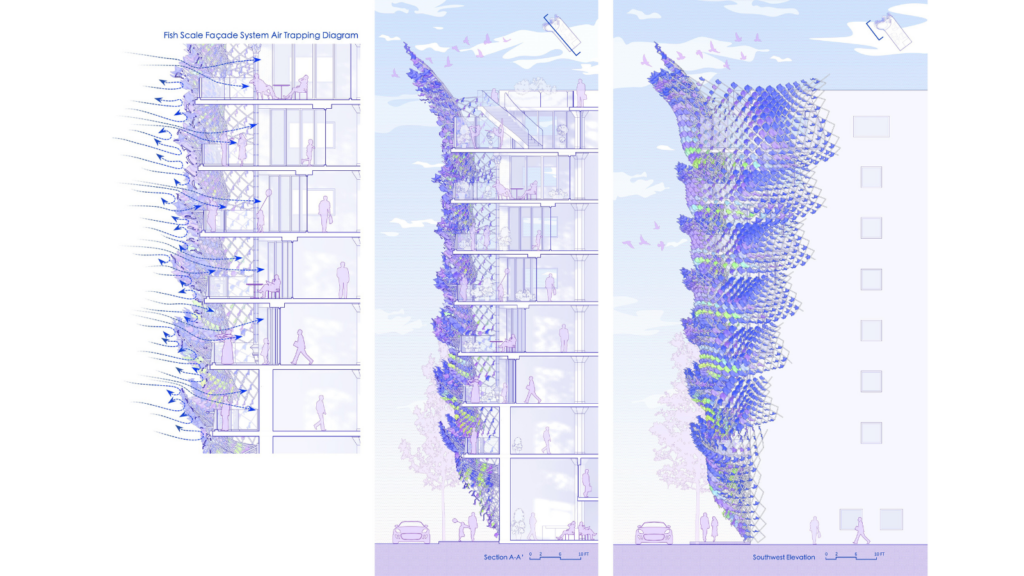
The intricate design and arrangement of fish scales inspire a new approach to building facades, combining metallic and multi-colored glazing to breathe new life into old structures. The protective properties of scales, influenced by their shape, size, density, and curvature, are leveraged to enhance the building’s performance against environmental factors. Additionally, the aesthetically pleasing diagonal arrangement and rhythm of the scales contribute to the building’s visual appeal.
By emulating the natural arrangement and material of fish scales, the facade design achieves a balance between beauty and functionality. The research further employs computational fluid dynamics (CFD) simulations to optimize the design for sun protection, ventilation, and thermal insulation. These simulations help refine the facade’s ability to manage heat and airflow, ensuring a comfortable and energy-efficient environment.
Overall, this project demonstrates the potential of biomimicry in architecture, using the adaptive strategies of fish scales to create innovative and sustainable building designs. The integration of advanced 3D printing techniques and materials ensures that the facade not only meets performance standards but also stands out as a visually striking element in the urban landscape.
